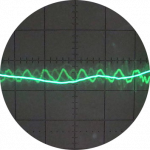Controversial opinions - pure weather compensation, buffer tank, heat loss, oversized heat pumps
Reference: This is my heat pump.
Just watched this video "Are buffer tanks required for Air Source Heat Pump systems?" - great video, very respectful conversation. My only point for potential improvement for next time... get someone with an different point-of-view involved. It made me think...
Ok, moving on to the first (potentially) controversial opinion. Also, I'm very open to be convinced otherwise to any of the below!:
1. Heat loss calculations/surveys are a waste of time
It's worth noting I still do it... just so I can laugh at it afterwards.
Instead, where possible, get the customer to run their existing boiler like a HP and run this test:
- Wait for a really cold day, ideally the "design temperature" for the area you are in
- Lower the flow temp on the boiler to as low as you can and still maintain comfort (get a few cheap temp sensor displays and put around the house)
- Set the room temp schedule to be 20c (or whatever you want) for the entire period of the test
- Turn off the DHW schedule from the (system) boiler, use the immersion for the test period - we're testing heat loss not DHW production...
- Make a note of the gas meter reading and time
- Wait 24 hours and make a note of the gas meter reading again
Heat loss = (gas consumption (in kWh) x 0.9 ) / 24
For example, if you consumed 120 kWh of gas in a 24 hour period then: (120 x 0.9) / 24 = 4.5kW heat loss
Assumption:
- Your boiler is a condensing boiler (installed after 2008 I believe are all condensing) - we're being generous and saying the boiler is 90% efficient
- Your flow temp is below 55c (it's actually going to condense)
- For reasonable results, you want the average outdoor temp to be the MCS design temp
- Ideally, try to reduce solar thermal gain as well...
- Do this for several days when it's cold, compare the results...
I've asked people for their smart meter data before... makes life so much easier...!
I used this method for my own house, it's looking spot on (4.5kW). The heat loss calculation (traditional way) came out at 6.76kW...
2. Get a bigger heat pump than required
I reckon this might be the most controversial one...
Ok, here goes...
1. Extending your house ever? Bigger heat pump...
2. We're told to match the homes heat loss to the heat pump itself... what about DHW production..? What about DHW production at -3c? What about DHW production at -3c when the tank is 300L and the heat pump rating is ~4kW...?!?
Some explanation may be required for homeowners on this one: Generally speaking, when in DHW mode, it means there is no heat for central heating. When it's -3c and you have a 300L cylinder, it'll take at least 2.5 hours to heat the tank to ~55c. That's 2.5 hours your house has no heating. If you size the HP for your heat loss, it will struggle to get the house back up to temperature.
3. Bigger heat pumps generally have better COP figures. The most efficient heat pump, is the heat pump that is NOT running. I chose a heat pump based on performance figures (and... the ability to tap into the Modbus to re-write the weather compensation algorithm...) - I try and keep my heat pump in it's optimal COP range, regardless if it's producing too much heat. I can just turn it off... (More explanation in the next controversial opinion)
UFH helps a lot here, as it takes a while to react as it's a huge amount of thermal mass.
4. You can run a hot tub off it!! This was genuinely one of my drivers for going bigger... and the reason for controversial opinion No.4
However, if you do a standard heat loss calculation survey (not what I suggest above), you'll be fine... because it'll be ~33% bigger than the actual heat loss anyway 😉
3. Pure weather compensation is bad
Disclaimer/Admission: I'm a software engineer... I'm not using the standard weather comp control from the manufacturer, I wrote my own. I appreciate this is not available to the general public. The point I'm making is, with better controls, you can achieve better efficiency. Manufacturers... DO BETTER!
Room influence is really important, maybe it's just my lack of understanding here, but asking the customer to change the weather comp curve...??? Is this the best we can do...?
I get the impression the industry has settled on pure weather comp being "the best" because it's easy way out, rather than actually trying to model the property and figuring out what works best. Hint... knowing what is happening inside and outside the property is really helpful for controlling it!
As mentioned above, bigger heat pump dumps heat into the house at optimal COP (500%+), calculate how much heat has been provided over a given time, calculate what the heat loss was for that period... turn the heat pump off allowing actual heat loss to catchup... monitor indoor temp and adjust accordingly.
4. Not all hydraulic separation is bad
Firstly, traditional buffer tanks are dogshit and should never be used... However, the NRG Zone is a work of art!
I have one, the flexibility it provides is just amazing. My original design had two "zones" at different design temps. Downstairs (UFH) flooring could not exceed 27c, this was a manufacturer limit on the flooring itself. Upstairs I wanted the ability to run the radiators hotter... NRG enabled this... and the hot tub... and it looks cool.
Edit: I forgot to add in: With the NRG you can do cool stuff, like move heat around without the need for the ASHP at all. For example... in the summer I cool the UFH slab by running it's circulation pump and pushing it's heat to the hot tub (which is usually cold). Or (planned upgrade) I can run a FCU for Air Con in the summer. I've also cooled the UFH slab with the ASHP, it's ok... cooler air would make a bigger difference.
Welcome to the forums.
Posted by: @stuartornumMy only point for potential improvement for next time... get someone with an different point-of-view involved.
For that episode, I invited more than 10 pro-buffer installers to come on. They all declined. We’ve schedule part two to keep the conversation going, but the pro-buffer brigade are still declining to come on, which I find odd.
Get a copy of The Ultimate Guide to Heat Pumps
Subscribe and follow our YouTube channel!
Thanks for these, you make some good points (at least in my opinion), here are some comments from me
Posted by: @stuartornum1. Heat loss calculations/surveys are a waste of time
It's worth noting I still do it... just so I can laugh at it afterwards.
Instead, where possible, get the customer to run their existing boiler like a HP and run this test:
Im not sure they are a waste of time because they help size emitters, but I 100% agree that, if you can measure the actual loss then do so. I personally now use the term GIGO fabric spreadsheet. FWIW, my 3 hr heat loss surveys (two, one of which I paid for, the other was free) came out at 16kW, the measured loss is 7.5kW.
Posted by: @stuartornum
2. Get a bigger heat pump than required
I reckon this might be the most controversial one...
Interesting. I would observe
Extending an older house can actually reduce heat loss
I haven't personally seen the evidence that bigger heat pumps have significantly better COPs - can you point to it please?
there are reasons other than performance why size matters (aesthetics, planning permission, availability of space).
I would say: Know properly what the loss is including the requirement for DHW production and then make an intelligent design choice taking all the factors into account, dont just add 30-50% willy-nilly.
Posted by: @stuartornum
3. Pure weather compensation is bad
I would dispute that and on its own its a dangerous message. WC is actually a tried and successful technology, both for boilers and heat pumps, used for over two decades in several mainland european countries. Properly adjusted in a tolerably insulated house it can do a very good job.
But I wouldn't dispute that there are other things which could be done (or at least offered) in addition and I certainly would agree that the 'bog standard' UI for WC (basically dial in 4 points) is cr*p.
Posted by: @stuartornumbut asking the customer to change the weather comp curve...??? Is this the best we can do...?
No it isnt and neither is it the best we have. Some, Vaillant for example, have worked that out in their UI.
So what Vaillant do for example (its the same UI both for boilers and heat pumps) is have a series of pre-defined curves from which a selection is made (using 1 number) only by the installer. The householder can then alter the 'target temperature'. Actually, as it explains in the manual, what this is doing is shifting the WC curve, but the householder is not exposed, unless they choose to be, to the complexity. Genius.
Several manufacturers, including but not limited to Vaillant and Mitsubishi, offer some form of auto adaption where the installer sets up basic WC parameters and the heat pump learns how to tweak them and/or some form of load (ie IAT) compensation layer on top of the WC layer.
Posted by: @stuartornumAs mentioned above, bigger heat pump dumps heat into the house at optimal COP (500%+), calculate how much heat has been provided over a given time, calculate what the heat loss was for that period... turn the heat pump off allowing actual heat loss to catchup... monitor indoor temp and adjust accordingly.
Thats pretty much a description of how the Vaillant control loop operates when its cycling.
Unfortunately some manufacturers have not any or all of these advances.
Posted by: @stuartornum4. Not all hydraulic separation is bad
Firstly, traditional buffer tanks are dogshit and should never be used...
I think the installers on the recent podcast on this forum about buffers say should not be used in 99% of cases. However they were all 'anti-buffer' people, because @editor was unable to get anyone to come on who advocates buffers (which says all you need to know IMHO)
Posted by: @stuartornumHowever, the NRG Zone is a work of art!
Cant comment on this, but as a general point I personally think there is a place for some add on controls designed/adapted specifically for heat pumps. Unfortunately we are currently 'blessed' with a load of add-on controls which aren't and which can do a lot of harm when inserted into a heat pump system, yet their manufacturers don't tell us that. That's why a simple message - keep the system simple and shun (most) add-ons - is probably best for most at the current time.
PS Conscious that I mention Vaillant 3 times - I have no connection with them or any other HP manufacturer, I just happen to have a Vaillant heat pump so am beginning to understand some of the subtleties of what it does which arent evident from the manual.
4kW peak of solar PV since 2011; EV and a 1930s house which has been partially renovated to improve its efficiency. 7kW Vaillant heat pump.
Posted by: @stuartornum
3. Pure weather compensation is bad
I would dispute that and on its own its a dangerous message. WC is actually a tried and successful technology, both for boilers and heat pumps, used for over two decades in several mainland european countries. Properly adjusted in a tolerably insulated house it can do a very good job.
I second this - pure weather compensation works extremely well on my Daikin - no cycling when it's mid-range OATs and it maintains the inside temperature very precisely in my house even when the OAT dips below freezing. This week in the deep south west we went from -3º to 14º in just a few days - my heap pump didn't so much as blink.
However, I am beginning to think that the 'discourse' around heat pumps over complicates everything unnecessarily. Weather Compensation is not rocket science particularly when you have something simple like an 'over/undershoot dial to test numbers very simply in real OAT situations. Meanwhile, indoor thermostats cause half the problems by fighting with the heat pump.
Thanks for your replies, really appreciate the input.
Posted by: @jamespaIm not sure they are a waste of time because they help size emitters, but I 100% agree that, if you can measure the actual loss then do so. I personally now use the term GIGO fabric spreadsheet. FWIW, my 3 hr heat loss surveys (two, one of which I paid for, the other was free) came out at 16kW, the measured loss is 7.5kW.
Agree it's useful for emitters. If you can run the boiler flow temp of ~35c-45c and the entire house is "comfortable" - it's safe to assume emitters are fine. That being said, mine were fine, I still chose to upgrade 8 of the 10 radiators... because rads are cheap and mine were 25+ years old, also can run a lower flow temp.
Posted by: @jamespaI haven't personally seen the evidence that bigger heat pumps have significantly better COPs - can you point to it please?
there are reasons other than performance why size matters (aesthetics, planning permission, availability of space).
Vaillant's 10kW and 12kW models have the best SCOP figures in the line-up:
Riello/Midea/etc 10kW is the best in the range: https://midsummerwholesale.co.uk/pdfs/riello-nxhm-datasheet.pdf
Fair point on other reasons (planning, aesthetics etc). I believe recent planning changes have alleviated this to some degree.
Posted by: @jamespaI would dispute that and on its own its a dangerous message.
Posted by: @luciaI second this - pure weather compensation works extremely well on my Daikin
I'm pleased this has at least sparked a discussion!
For clarity: when referring to "pure weather compensation", I'm referring to no indoor feedback is present. I'm not talking about Nest/Hive etc...
For me "pure weather compensation" isn't good enough, you're missing out on a higher level of control and efficiency. If you have access to all this data (not just room temp), why not use it to inform what the flow temp should be.
For example, I know:
- How many people are in the house at any one time (adults... or anyone with a phone) - people generate heat (about 100W at rest), pure weather comp doesn't take this into account
- Solar gain - this generates heat, pure weather comp doesn't take this into account
- Weather forecast, if you know the OAT is going to dip below 3c in N hours (where my HP starts doing defrosts), you can dump a load of heat into the property before hand and therefore achieve higher COP, pure weather comp cannot do this
- Time-of-use tariffs, I don't believe pure weather comp is particularly well designed for this. If you're prioritising off-peak...
More data, from more sources, means more options for "better" decisions. Those decisions may choose to bias efficiency or they may choose operating cost is more important. The point being, relying on just the OAT to control something as dynamic as a house with all it's potential inputs... sounds insane to me. I'm pleased it is working for you, I believe it could be better... (at the expense of complexity, totally accept that)
Posted by: @jamespaCant comment on this, but as a general point I personally think there is a place for some add on controls designed/adapted specifically for heat pumps. Unfortunately we are currently 'blessed' with a load of add-on controls which aren't and which can do a lot of harm when inserted into a heat pump system, yet their manufacturers don't tell us that. That's why a simple message - keep the system simple and shun (most) add-ons - is probably best for most at the current time.
Totally understand the keep it simple approach, however, just because something is decades old and "works well", is no excuse to not explore potential alternatives/improvements.
Posted by: @stuartornumTotally understand the keep it simple approach, however, just because something is decades old and "works well", is no excuse to not explore potential alternatives/improvements.
Posted by: @stuartornumFor me "pure weather compensation" isn't good enough, you're missing out on a higher level of control and efficiency. If you have access to all this data (not just room temp), why not use it to inform what the flow temp should be.
I agree that just because its decades old is not a good reason, but the point is that it is decades old and has been proven to work.
Its also not just because its a simple approach, there is actually a very good reason to start with WC as a base, and that's the delay in response of IAT to changes, caused by the house inertia. If you study control theory (which you may well have done) you will know that delays in feedback loops can cause instability, particularly when the characteristics of the feedback loop change during the delay period. This is the case with house heating systems, the OAT, which is ultimately the driving force (much more so than any of the other things you mention) can change quite dramatically in a few hours, much quicker than the house responds.
That doesn't mean that other variables cant be taken into account and added into the mix, but starting with WC as a base gets you pretty near without risking instability and without depending on 'the cloud', and a server which likely will be switched off during the lifetime of the heat pump, whereas it would if for example your primary control loop depended on weather forecasts.
Nest and Hive are not, so far as I know, currently optimised for heat pumps and will almost certainly reduce efficiency and cost if used as the principal control mechanism.
Many heat pumps do feature more sophisticated control loops, and most that don't support modbus and are supported by Homely which is designed for heat pumps, so there are more sophisticated solutions emerging. These all however start with WC as the basis and then 'tweak'.
So whilst I would agree that
Posted by: @stuartornumMore data, from more sources, means more options for "better" decisions.
I cannot currently see any realistic alternative to WC as the basic control mechanism if you want something robust which basically works and doesnt depend on flaky cloud services. However as I already said, the 'typical' UI to WC is cr*p.
Posted by: @stuartornumVaillant's 10kW and 12kW models have the best SCOP figures in the line-up:
Riello/Midea/etc 10kW is the best in the range:
Fair point on other reasons (planning, aesthetics etc). I believe recent planning changes have alleviated this to some degree.
OK I agree that the published figures say that (and Im not doubting them). Of course what you really need to compare is (eg) a 10kW heat pump in a 7kW house with a 7kW heat pump in a 7kW house. Thats a more complicated comparison.
Some of the difference between the sizes may be down to fixed components of consumption which are of course the same in absolute terms for a 3kW pump as for a 10kW pump but more in relative terms so have a larger influence on SCOP.
The planning changes arent yet in force, but they will alleviate to an extent, although lower capacity pumps are generally quieter (according to the spec) and the planning changes don't affect the fact that this may matter.
As I say for me its a case of work out the demand properly then make a decision based on the various considerations, not as simple as 'oversize'.
4kW peak of solar PV since 2011; EV and a 1930s house which has been partially renovated to improve its efficiency. 7kW Vaillant heat pump.
@jamespa For clarity, I'm not saying WC is bad, I'm saying "pure" WC is bad (actually, "not good enough"). The base for my system is WC - I totally agree it's the ideal place to start. I'm modifying the heat demand figure and looking for ways to stay within the HP's optimal params, and run it cheaper... which is usually mutually exclusive with efficiency
I suppose where I'm coming from is: in another two decades, do you think we'll be happy using pure weather comp only? I don't think we will, I predict we'll be looking to augment it with additional data. And on that thought, I predict we will be looking to achieve that via occupancy, weather predictions and utility prices. We already do this in commercial real estate leveraging the BMS.
In regards to being cloud connected, luckily for me, this is my background. Pulling in weather data periodically to augment the basic WC is trivial. If no connection, just fallback to the basic model.
Posted by: @jamespaOf course what you really need to compare is (eg) a 10kW heat pump in a 7kW house with a 7kW heat pump in a 7kW house. Thats a more complicated comparison.
I will happily be that guinea pig!
@stuartornum Sounds rather like what my Homely controller does right now! Regards, Toodles.
Toodles, heats his home with cold draughts and cooks food with magnets.
Posted by: @toodlesSounds rather like what my Homely controller does right now! Regards, Toodles.
Big fan of Homely! One of the reasons being... it's not pure weather comp, it uses room influence.
I have Homely on my setup, currently turned off as it doesn't play well with other devices being on the modbus (floods it). I've asked Homely several times for an API... fingers crossed.
I believe Homely is in the best position to be v2.0 for weather comp. Here's some features/data I'd like to see added:
1. An API (a local API would be even better)
2. Multiple zones (I know people are against zones generally, but the feature would still be nice)
3. Ability to change max/min flow temps without having to call them and ask them to make the change manually (I believe this feature is coming)
4. Release anonymised performance data of heat pumps
5. Ability to use different sensors, for example it uses the OAT of the HP itself... which may be in direct sunlight... I'd like to push my own OAT to Homely.
6. Ability to dynamically change the heat requirement
7. I don't believe they ask for the properties heat loss, they may determine this themselves over time based on the heat requirements... I'd like to be able to modify this dynamically (via the API)
Posted by: @stuartornumFor clarity, I'm not saying WC is bad, I'm saying "pure" WC is bad (actually, "not good enough"). The base for my system is WC - I totally agree it's the ideal place to start.
....
I suppose where I'm coming from is: in another two decades, do you think we'll be happy using pure weather comp only?
No, (if society survives that long which, given out bent for self destruction must be questionable).
Its my personal conviction that ToU tariffs will become more important to reduce the infrastructure costs of electrification to a manageable level. At that point you need more sophisticated control (as Homely and Havenwise already do). However you also need a 'disconnected' fallback. Heating is mission critical to a house and something that is mission critical needs to operate stand alone.
My concern with the comment "Pure weather compensation is bad" is that there are many people who dont understand WC or the benefits it can bring, and a sizable number whose reaction is 'WTF why not use a thermostat'. For this majority this is a very dangerous message. In the UK we failed, unlike several countries in mainland Europe, to adopt it for boilers, so its a technology associated (by the public) with heat pumps, even though that is actually nonsense. Its furthermore one that they don't understand (and most don't care to understand). Whilst you an I might discuss control theory, if you try that in a local pub (unless its in a university town), you aren't going to get far and you are going to be told whatever rubbish about heat pumps is currently circulating in certain parts of the media (trust me on this, I spend quite a lot of time in my local pub traying to avoid listening to this cr*p).
This is a major risk to heat pump roll out, not least because installers inevitably want to minimise call outs at any cost, so jacking up the WC way too high, telling the customer not to touch it, installing a thermostat for the homeowner to play with, and a buffer to 'sort it out' is the what many are drawn to. Thus we end up with the situation we have today, where many systems are poorly installed, poorly configured and so perform poorly, giving the fossil fuel powered media the opportunity to excuse to trash the only mass market technology we have for low carbon heating!
For me the (control) priority at the current time is that every heat pump should have an interface that the ordinary person can understand and which, if they play with it, actually does something sensible. Today that is far from the case. The likes of Vaillant have got to grips with this because they also produce boilers with WC and so have had to solve this problem. Im guessing that Bosch and Viessmann (who also make WC enabled boilers for the European market) may also have done so, but I don't know. Samsung, Midea and others haven't, probably because they didnt produce WC enabled boilers. Homely of course does it and more besides, and I think there is an argument (which I have heard from more than one installer) that Samsung, Midea and other heat pumps with a rather basic control interface should only be sold with Homely.
It feels like we agree much more than we disagree. Im quite sensitive to the 'messaging' which may be the source of our initial apparent disagreement!
4kW peak of solar PV since 2011; EV and a 1930s house which has been partially renovated to improve its efficiency. 7kW Vaillant heat pump.
Posted by: @jamespaMy concern with the comment "Pure weather compensation is bad" is that there are many people who dont understand WC or the benefits it can bring, and a sizable number whose reaction is 'WTF why not use a thermostat'. For this majority this is a very dangerous message.
Well said!
Posted by: @jamespaIt feels like we agree much more than we disagree. Im quite sensitive to the 'messaging' which may be the source of our initial apparent disagreement!
I think we do! I must admit, I do like playing devils advocate and the "messaging" was designed to provoke. Apologies...
Posted by: @jamespa...that Samsung, Midea and other heat pumps with a rather basic control interface should only be sold with Homely.
I could not agree more with this statement.
This leaves installers in an interesting position... with Homely providing arguably the best controls (that you can buy) in the market (IMHO), couple that with a Midea/Riello/Samsung etc... why bother with the "premium" brands such as Vaillant, Viessmann, Stiebel Eltron etc... I mean, Riello is owned by the same parent as Viessmann (Carrier).
-
Buffer tank required? Samsung 12kW heat pump
3 years ago
Currently viewing this topic 2 guests.
- 26 Forums
- 2,360 Topics
- 53.5 K Posts
- 307 Online
- 6,026 Members
Join Us!
Worth Watching
Latest Posts
-

RE: My Powerwall 3 Consumes 3-4 kWh/Day in Self-Consumption: Is This Normal?
@caron, I'm looking into this for you... from my own pe...
By Mars , 46 minutes ago
-
RE: Mitsubishi Ecodan R290 10kW performance
@majordennisbloodnok Delat T 3C, no defrosting and I am...
By Ecoste , 1 hour ago
-
RE: New Fogstar 15.5kWh upright solution
SITREP #5 (I think) Milestone completed toda...
By GGW , 3 hours ago
-
RE: Octopus Cosy Heat Pump Owners & Discussion Thread
The FT levels off at either the set point OR the minimu...
By AndrewJ , 3 hours ago
-
RE: MyVaillant Connect Regular Disconnect
Thanks. Yes, if the time is consistently 11pm every nig...
By buckwem , 3 hours ago
-

RE: Speedcomfort radiator fans
My take on Speedcomfort radiator fans: If anyone w...
By Mars , 9 hours ago
-
RE: Midea ASHP – how to set weather compensation
@pash44pump I have yet to come across any Clivet or Mid...
By benson , 9 hours ago
-
RE: Who's your electricity provider and what's your tariff?
@transparent Thanks, this helps. Could it be that St...
By Batpred , 10 hours ago
-
RE: Clivet ASHPs and weather compensation
Simon did share a lot of very helpful advice. On furthe...
By ambris , 10 hours ago
-
RE: Home Assistant vs ESPAltherma.
@majordennisbloodnok Thanks very much.
By Ubert767 , 11 hours ago
-

RE: Setback savings - fact or fiction?
I could, but I think we can do better, by plotting hour...
By cathodeRay , 1 day ago
-
RE: Advice on internal circulation pump noise
Extend the primary branch and make sure you have more t...
By ASHP-BOBBA , 1 day ago
-

RE: External pipework insulation
Oh Dear! that's appalling pipe work, should've been in ...
By dgclimatecontrol , 1 day ago
-

RE: Jokes and fun posts about heat pumps and renewables
By Morgan , 1 day ago
-

RE: Controlling Daikin Altherma via P1P2 and Home Assistant
On the contrary, @toodles, that’s a lot of help. I’d ne...
By Majordennisbloodnok , 2 days ago
-

Parsnip, Bacon & Coconut Milk Soup
First let me say, I am only a cook because I am human a...
By Toodles , 2 days ago
-
RE: Electricity price predictions
Ben Watts posted on LinkedIn that he had updated this w...
By Judith , 2 days ago
-

RE: The good, the bad and the not that great – my heat pump installation
Small update, Emailed and Spoke to Midea UK and they ...
By Burtis , 2 days ago





